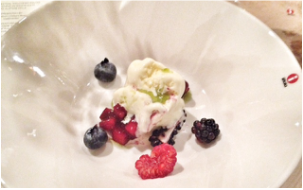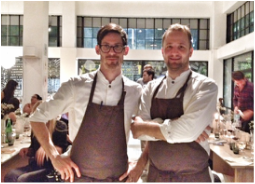I had the amazingly good fortune of sampling 16 dishes from Sweden's Michelin-rated restaurant, Gastrologik prepared by co-founders Chef Anton Bjuhr and Chef Jacob Holmström. One of my favorite dishes was the spruce ice cream, made with pine needles. Both Chefs are down-to-earth, friendly and happy to share the recipe below.
Ingredients
750g milk
250g whole cream
200g egg yolk
135g sugar
15g spruce needles
Directions
Bring milk and cream to a boil, whisk sugar and eggs together. Pour the hot milk/cream to the egg mixture. Put back in a pan and warm during stirring to 84 degrees celsius. Add the spruce needles to the ice cream mixture and leave to cool down, keep in fridge over night. Then with a blender, mix a small amount of the ice-cream mixture with the spruce needles, then strain. Freeze in a ice-cream machine.
Wondering where to find the right pine needles? Chef Anton Bjuhr gave the following advice, "Any pine needles will do. Sometimes it´s possible to find pine needles at the florist but they can be sprayed with different toxics (so you want to be very careful). Straight from the forrest is better, but wash them thoroughly."
The Food Scene in Stockholm: An Interview with Anton Bjuhr
WTJ: Please describe the Nordic culinary scene and what are some of its characteristics?
I would say that is all based on the produce that you can find around you, to respect our own produce and listen to nature and what it has got to offer
WTJ: How did you get your start; what was the inspiration?
After many years of working in different restaurants in different countries, we came to a point where we wanted to express ourselves, and like many other chefs our dream was to open our own restaurant. And so we did after some years of planning.
What's the philosophy of Gastrologik?
Focus on the ingredients and produce, close cooperation with producers and suppliers
We put as much effort in finding the best ingredients as in refining them.
Respect and honesty
How did you meet your partner?
We met in a restaurant called Linnea in Gothenburg, in 2002. We started working there at the same time . Jacob works with savory and I ( Anton) work with sweet and bread.
WTJ: Tell our readers about your garden....about how you source your dishes (example lichen in the forest - is this your staff or do you have a vendor?)
In april this year we built a small garden in the back yard of the restaurant
To involve the whole staff, to learn and understand more about how and why things grow as they do
To be able to harvest some things minutes before serving. We start every week by harvesting vegetables at Rosendahl Garden, which is a biodynamic garden on the island of Djurgården. It's a 5 min drive from the restaurant. This is where our week begins from early spring to late autumn. And for the winter we make sure to harvest enough during summer and autumn to preserve and to winter store.
We forage for wild things as the season allows, this way we see whats good to use now and what is about to happen, like this we adapt to nature and can follow it A lot of this we do ourselves but we also work with a long list of different producers, depending on their specialty. We try to get to the source straight away like this we get better and fresher produce and it's easier to get an understanding
As little as possible we work through vendors
WTJ: What's very typical of traditional Swedish food? What's typical of contemporary culinary scene in Stockholm?
Quite heavy food (using a lot of butter and cream) I would say that we use a lot of preserving techniques, like pickling, curing and drying for example.
Using the same techniques as above, but in a more modern way.
Fresher in that way of using less butter and cream, letting the produce it self take more place
www.gastrologik.se
Ingredients
750g milk
250g whole cream
200g egg yolk
135g sugar
15g spruce needles
Directions
Bring milk and cream to a boil, whisk sugar and eggs together. Pour the hot milk/cream to the egg mixture. Put back in a pan and warm during stirring to 84 degrees celsius. Add the spruce needles to the ice cream mixture and leave to cool down, keep in fridge over night. Then with a blender, mix a small amount of the ice-cream mixture with the spruce needles, then strain. Freeze in a ice-cream machine.
Wondering where to find the right pine needles? Chef Anton Bjuhr gave the following advice, "Any pine needles will do. Sometimes it´s possible to find pine needles at the florist but they can be sprayed with different toxics (so you want to be very careful). Straight from the forrest is better, but wash them thoroughly."
The Food Scene in Stockholm: An Interview with Anton Bjuhr
WTJ: Please describe the Nordic culinary scene and what are some of its characteristics?
I would say that is all based on the produce that you can find around you, to respect our own produce and listen to nature and what it has got to offer
WTJ: How did you get your start; what was the inspiration?
After many years of working in different restaurants in different countries, we came to a point where we wanted to express ourselves, and like many other chefs our dream was to open our own restaurant. And so we did after some years of planning.
What's the philosophy of Gastrologik?
Focus on the ingredients and produce, close cooperation with producers and suppliers
We put as much effort in finding the best ingredients as in refining them.
Respect and honesty
How did you meet your partner?
We met in a restaurant called Linnea in Gothenburg, in 2002. We started working there at the same time . Jacob works with savory and I ( Anton) work with sweet and bread.
WTJ: Tell our readers about your garden....about how you source your dishes (example lichen in the forest - is this your staff or do you have a vendor?)
In april this year we built a small garden in the back yard of the restaurant
To involve the whole staff, to learn and understand more about how and why things grow as they do
To be able to harvest some things minutes before serving. We start every week by harvesting vegetables at Rosendahl Garden, which is a biodynamic garden on the island of Djurgården. It's a 5 min drive from the restaurant. This is where our week begins from early spring to late autumn. And for the winter we make sure to harvest enough during summer and autumn to preserve and to winter store.
We forage for wild things as the season allows, this way we see whats good to use now and what is about to happen, like this we adapt to nature and can follow it A lot of this we do ourselves but we also work with a long list of different producers, depending on their specialty. We try to get to the source straight away like this we get better and fresher produce and it's easier to get an understanding
As little as possible we work through vendors
WTJ: What's very typical of traditional Swedish food? What's typical of contemporary culinary scene in Stockholm?
Quite heavy food (using a lot of butter and cream) I would say that we use a lot of preserving techniques, like pickling, curing and drying for example.
Using the same techniques as above, but in a more modern way.
Fresher in that way of using less butter and cream, letting the produce it self take more place
www.gastrologik.se
The potato is worth exactly as much as the truffle, it is not nature that decides what´s good or bad, it’s you and me. (Philosophy of Gastrologik)
To read about Stockholm, click here.
To read about Josefin Haraldsson of the Stockholm Tourist Board, click here
To read about Josefin Haraldsson of the Stockholm Tourist Board, click here




 RSS Feed
RSS Feed